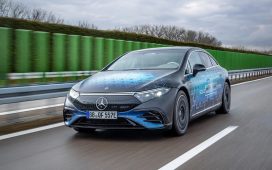- The switch to electric vehicles is still hampered by the high cost compared to gas cars.
- The higher upfront costs don’t consider several less obvious costs that can hit after buying an EV.
- Things like repairs and insurance are also more expensive for EVs.
The price of electric vehicles is still the biggest hurdle to most consumers considering a switch from gas-powered cars, and they might not even be factoring in some of the hidden costs associated with them.
A man in Scotland was recently shocked by a £17,374 ($21,000) bill to fix his Tesla after rain damaged the battery.
“I thought we would get a bill for £500 or £1,000,” Johnny Bacigalupo told Edinburgh Live. “When they said over 17 grand — it’s absolutely obscene. My heart missed a beat, honestly.”
While government tax credits can help with the initial vehicle purchase, EVs are still more expensive than gas cars, mainly because it costs a lot to make them. While there have been price cuts, automakers ramped up production, causing the demand — and prices — for parts to skyrocket, especially batteries.
The cost of the parts leads to issues that could make the cars much more expensive than the sales tag in the long run.
EV batteries are costly to repair and replace
Recurrent, a firm that studies battery health, surveyed 15,000 EV drivers in March and found that 1.5% needed battery replacements, which range between $5,000 and $20,000. The cars surveyed go back to 2011, but a vast majority were six years old or younger.
However, in some cases, it can cost even more.
Last year, a Tesla owner in Canada shared on TikTok that the company told him that a replacement battery would cost $26,000 when it died.
The batteries are easy to damage, difficult to repair, or even assess. Tesla’s Model Y battery has “zero repairability” after a collision, according to auto expert Sandy Munro.
Replacing a battery is so costly, that it can often be more than the car is worth, forcing insurance companies to write them off.
Insurance is more expensive for EVs
Easy write-offs from insurance companies lead to higher premiums.
According to Bankrate, the average cost to insure a Tesla ranges from $2,503 annually to $4,066, depending on the model. Meanwhile, the US average for all cars is about $2,148.
Those premiums are driven by higher repair costs. While EVs need to be fixed less often than gas cars, those repairs are more expensive.
According to Mitchell, a collision repair software company, the average repair cost for a non-Tesla EV is $269 higher than the average for all vehicles. For Teslas, each repair is $1,347 more than average.
There is also specialized labor required.
“Those parts can be pricey,” according to insurance provider Progressive. “If the battery pack is damaged, certain safety protocols are often necessary, adding more to the repair bill. Plus, there aren’t as many shops with technicians trained to fix electric vehicles versus traditional vehicles.”
Charging may require more than just a plug
Electricity prices can fluctuate greatly by state and time of year, but there are other less obvious costs associated with charging EVs.
According to a study from Anderson Economic Group, if other factors are considered, such as installing a charger and EV registration fees, most cars cost more to charge than to fuel with gas.
Most EV owners charge their cars at home and most vehicles come with a charger that can plug into a standard 110-volt home outlet. However, a long charge with this type of outlet may not be enough for some journeys: One driver of a Ford Mustang Mach-E told Insider they only got about 36 miles of range from an overnight charge.
To up the charging capacity, an owner needs access to a 240-volt outlet for a Level 2 charger, or can install one at home. They can purchase a Level 2 charger for between $200 to $1,000, depending on the features included. The installation adds about $1,000 to the total, according to Edmunds.
“If you don’t have a Level 2, it’s almost impossible,” Bloomberg automotive analyst Kevin Tynan, who researches EVs, told Insider when asked about getting sufficient charge into an EV.
And if you do have a Level 2 charger at home, you might have to declare it on your home insurance policy, which could increase that premium.
Other factors to consider
Another issue with EV batteries is that nobody knows their lifespan. If people interested in used EVs are worried about replacing an expensive battery, the resale value will take a big hit.
Lifespan is also a factor with tires. Because the batteries on EVs are so heavy, the cars are heavier than comparable gas vehicles. As a result, the cars require more expensive tires and those tires have to be replaced sooner than traditional car tires.
There are also indirect costs, such as time.
There is a good chance an owner will be forced to go to a dealer for repairs due to the complexity. This has led to long wait times, a lack of competitive pricing, and poor replacement parts inventory.
The cost differences between EVs and other cars will improve. The sticker prices will continue to come down, and smaller EVs are expected to have the same initial cost as their gas equivalents by 2025.
In the meantime, many EV owners are switching back to gas-powered cars.
According to a University of California-Davis study of 4,167 people, about 20% of EV owners purchased a gas car the next time, with most citing charging headaches. Of those who switched, 70% did not have a Level 2 charger at home.
As of February, the EV market share has risen to 8.5%, up from 2.6% in 2020. However, according to JD Power, the number of people they surveyed earlier this year who are “very likely” to buy an EV has remained steady since 2022, while the percentage of those who say they won’t switch to electric cars has grown.
NOW WATCH: Popular Videos from Insider Inc.
Loading…










